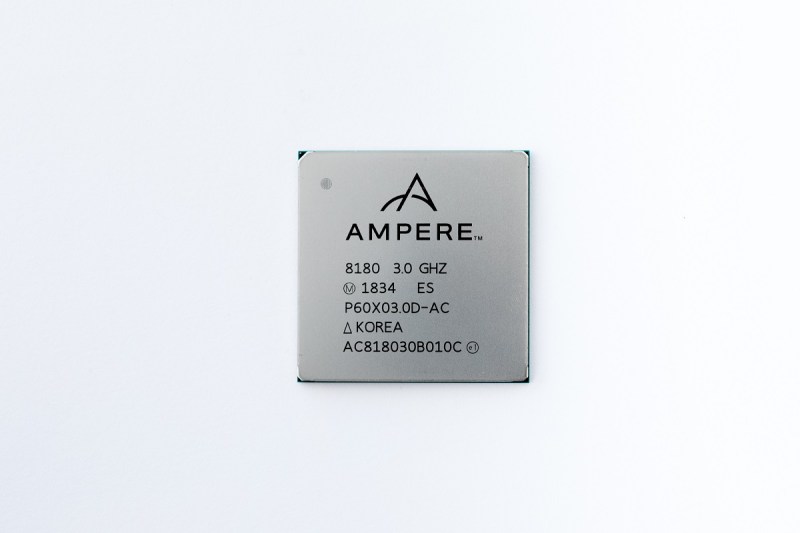Ampere is launching two versions of its first ARM-based 64-bit server processor today in a challenge to Intel’s dominance of data center chips.
Intel dominates about 99 percent of the server chip market with its x86-based processors, but Ampere is targeting power-efficient, high-performance, and high-memory capacity features with its Ampere eMAG processors for data centers.
Renee James, former president of Intel and CEO of Ampere, said in an interview with VentureBeat that customers can now order the chip from the company’s website. The chips are aimed at hyperscale cloud and edge computing, using the ARMv8-A cores. The chips target big data and in-memory databases.
Santa Clara, California-based Ampere is backed by private equity investment firm The Carlyle Group. James hopes to take on Intel with the ARM architecture used in the world’s smartphones, which is known for its efficiency in providing performance at very low power levels. Ampere was built from the ashes of Applied Micro Circuits, and it now has 400 employees.
June 5th: The AI Audit in NYC
Join us next week in NYC to engage with top executive leaders, delving into strategies for auditing AI models to ensure fairness, optimal performance, and ethical compliance across diverse organizations. Secure your attendance for this exclusive invite-only event.
Based on the SPECint benchmark performance, Ampere’s eMAG processor can deliver about twice the performance of the Intel Xeon Gold 6130 processor at about the same price, the company said. The eMAG with 32 cores and 3.3 Ghz in performance will sell for $850, and with 16 cores at 3.3 GHz will sell for $550.

Above: Renee James, CEO of Ampere, is the former president of Intel.
And Ampere’s eMAG is about three times better at performance per dollar compared to Intel’s Xeon D processors. You could also replace two Xeon Silver processors with one eMAG processor.
James said the company is also designing its next product to use 7-nanometer manufacturing with multi-socket and single-socket options for 2019.
“We have multiple products on the roadmap because the big companies buy into the roadmap, not just a single product,” James said.
Ampere came out of stealth about eight months ago, and it is partnering with world-class original device manufacturers and original equipment manufacturers (that is, big computer makers). The company isn’t yet ready to announce any customers, James said.
“The Ampere eMAG Arm-based SoCs and roadmap are well aligned with the demanding cost and performance requirements of hyperscale cloud computing customers,” said Drew Henry, senior vice president and general manager of the infrastructure business unit at Arm, in a statement. “This underscores the accelerated pace of innovation and broad workload support that infrastructure customers should expect to see from the Arm ecosystem.”

Above: Ampere has both 16-core and 32-core ARM-based server processors.
The Ampere eMAG platform is meant to lower total cost of ownership (TCO) in comparison to current rival chips. The emphasis will be on providing competitive performance per dollar and performance per watt for high-volume mainstream servers in data center, edge, storage, and web applications.
Ampere designed its cores, which feature eight DDR4-2667 memory controllers, 42 lanes of PCIe 3.0 for high bandwidth I/O, 125W TDP for maximum power efficiency, and a 16-nanometer FinFET manufacturing process at contract manufacturer TSMC.
“We are pleased with the collaboration between Ampere and our teams to deliver the first generation of products,” said Kevin Zhang, vice president of business development at TSMC, in a statement. “We look forward to continuing to see Ampere’s innovation in hyperscale cloud computing and working with them to deliver products to the market.”
Oracle also expressed its support.
“Ampere’s high performance, high memory capacity and 2P roadmap provide a strong platform to support Oracle’s enterprise workloads. We applaud Ampere for its aggressive roadmap and rapid progress,” said Edward Screven, chief corporate architect at Oracle, in a statement.
The category of 64-bit ARM server chips went through its own hype cycle a few years ago, with companies such as Advanced Micro Devices and Applied Micro trying to design chips based on ARM instead of Intel’s x86 architecture, which powers almost all of the world’s Windows PCs and Macs. But those companies failed. AMD shut its ARM project, and Macom acquired Applied Micro in 2016. The Carlyle Group bought the ARM central processing unit (CPU) division of Applied Micro from Macom in 2017. The acquisition was finalized late last year, and James took over as CEO, leaving her position as an operating executive at The Carlyle Group.
James stepped down from her role as Intel’s president in February 2016. She joined The Carlyle Group to make investments and found that semiconductor companies were becoming more popular as investments again. But she said that the amount of money required to bring chips to market is huge, and it required private equity backing from The Carlyle Group to get Ampere off the ground. James isn’t saying exactly how much.
Former Intel chip architect Atiq Bajwa is Ampere’s chief architect, while former AMD chip architect Greg Favor is a senior fellow at Ampere.
Ampere has an architecture license with ARM and is designing its own custom cores for its ARMv8-A 64-bit server chip. James served at Intel for decades. I met her when she was a technical assistant in the 1990s for then-CEO Andy Grove. He inspired her to move into management, and she climbed through the ranks and became president, the No. 2 job, in 2013. She announced she was leaving in mid-2013 and departed in February 2016.


